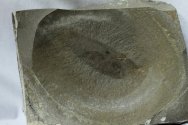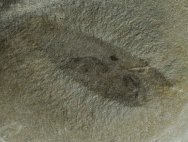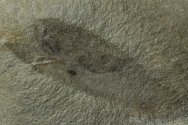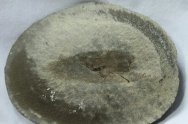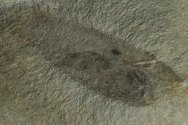 Description:
The Bear Gulch Limestone is a deposit of some 70 square km in
extent and 30 m in depth that has been a source of one of the
most diverse assemblages of fossil fish with some 110 species
having been described over the past 30 years. Most were new to
science, and provided a unique view of the marine environment
of Mississippian times. Fine preservation of both fish and invertebrates
is a hallmark of these Description:
The Bear Gulch Limestone is a deposit of some 70 square km in
extent and 30 m in depth that has been a source of one of the
most diverse assemblages of fossil fish with some 110 species
having been described over the past 30 years. Most were new to
science, and provided a unique view of the marine environment
of Mississippian times. Fine preservation of both fish and invertebrates
is a hallmark of these  deposits,
presumably due to an anoxic depositional environment. First discovered
in the early 1970s,
this enigmatic creature was found to contain conodonts within,
and was such termed the first conodont animal. Some 20 years
later it was determined that the conodonts were not native to
the specimen, but a result of predation, resulting in conodont
within the interior. It is still an open question as to the affinities
of this enigmatic metazoan. The genus derives its name from the
belief that it has a blind gut, much like some coelenterates.
What is a mystery is that most animals having blind guts are
either sessile or at most slow-moving while this one has the
streamlined body and fin of an actively-swimming predator. Note
the darkened circular structure, known as a deposits,
presumably due to an anoxic depositional environment. First discovered
in the early 1970s,
this enigmatic creature was found to contain conodonts within,
and was such termed the first conodont animal. Some 20 years
later it was determined that the conodonts were not native to
the specimen, but a result of predation, resulting in conodont
within the interior. It is still an open question as to the affinities
of this enigmatic metazoan. The genus derives its name from the
belief that it has a blind gut, much like some coelenterates.
What is a mystery is that most animals having blind guts are
either sessile or at most slow-moving while this one has the
streamlined body and fin of an actively-swimming predator. Note
the darkened circular structure, known as a  ferrodiscus. This
circular structure has a high concentration of iron, hence the
name. It is not know for sure what its function was, but some
researchers think it had something to do with the circulatory
system. The most striking feature of this one is the possession
of conodonts within the interior seen as darkened spots which
show up best on the more lightly-colored counterpart. Whether
the animal contains them as a result of ingestion of another
organism or because they were native to the taxon is still a
topic of debate. ferrodiscus. This
circular structure has a high concentration of iron, hence the
name. It is not know for sure what its function was, but some
researchers think it had something to do with the circulatory
system. The most striking feature of this one is the possession
of conodonts within the interior seen as darkened spots which
show up best on the more lightly-colored counterpart. Whether
the animal contains them as a result of ingestion of another
organism or because they were native to the taxon is still a
topic of debate.
References:
Melton, W and Scott, Geological Society of America,
Special Paper 141, pp 32-65, 1973
Morris, S. Phil. Trans. R. Soc.
Lond. B, 327, pp 595-624, 1990
|


